Employment Relations Theories and Workplace Conflict: A Report
VerifiedAdded on 2021/05/31
|8
|2073
|327
Report
AI Summary
This report provides an overview of employment relations theories, including unitarism, pluralism, and radicalism, and their roles in addressing workplace conflicts. It examines the application of these theories within the context of human resource management (HRM) at the University of Sydney, Australia. The report discusses how these theories can both facilitate conflict resolution and, in some cases, create challenges within an organization. It highlights the significance of understanding employment relations for effective employer-employee relationships and organizational success. The report further explores specific issues that can arise in the workplace, such as poor communication, emotional decision-making, sexual harassment, and discrimination, and considers the role of unions in addressing these challenges. The analysis underscores the importance of HRM practices in fostering positive employee relations and achieving organizational goals, emphasizing the need for careful consideration of employment relations theories to enhance staff loyalty and reduce absenteeism.
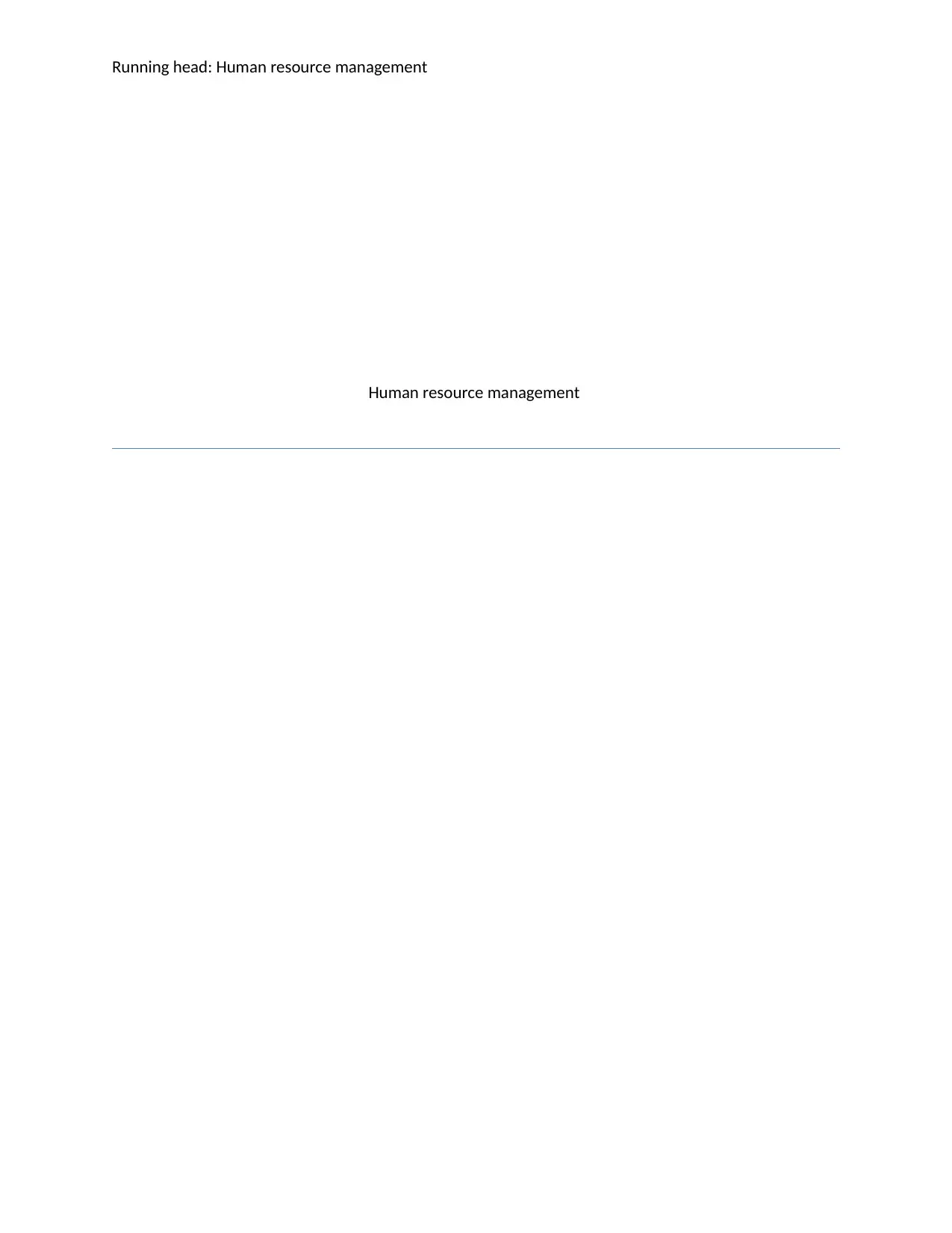
Running head: Human resource management
Human resource management
Human resource management
Paraphrase This Document
Need a fresh take? Get an instant paraphrase of this document with our AI Paraphraser
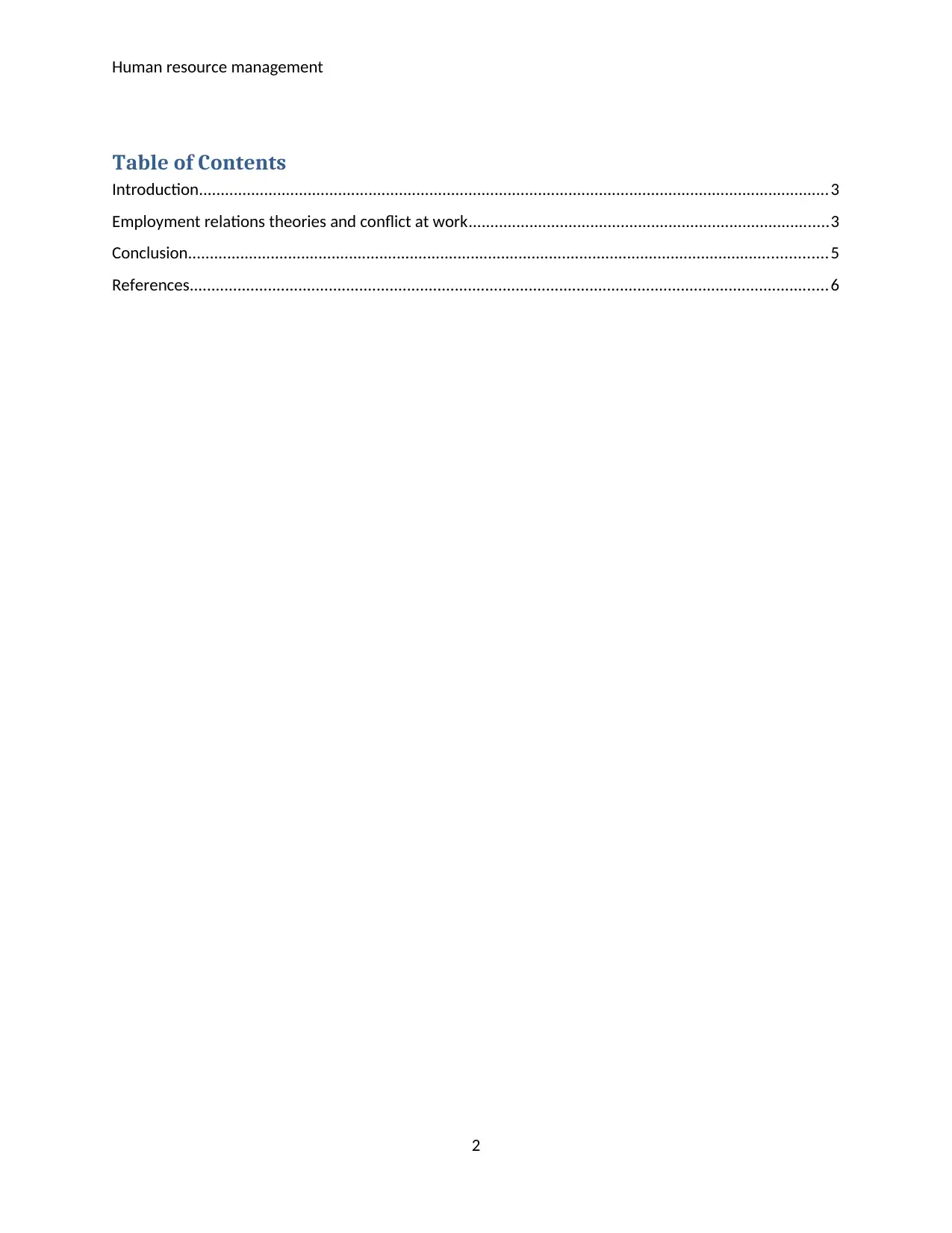
Human resource management
Table of Contents
Introduction.................................................................................................................................................3
Employment relations theories and conflict at work...................................................................................3
Conclusion...................................................................................................................................................5
References...................................................................................................................................................6
2
Table of Contents
Introduction.................................................................................................................................................3
Employment relations theories and conflict at work...................................................................................3
Conclusion...................................................................................................................................................5
References...................................................................................................................................................6
2
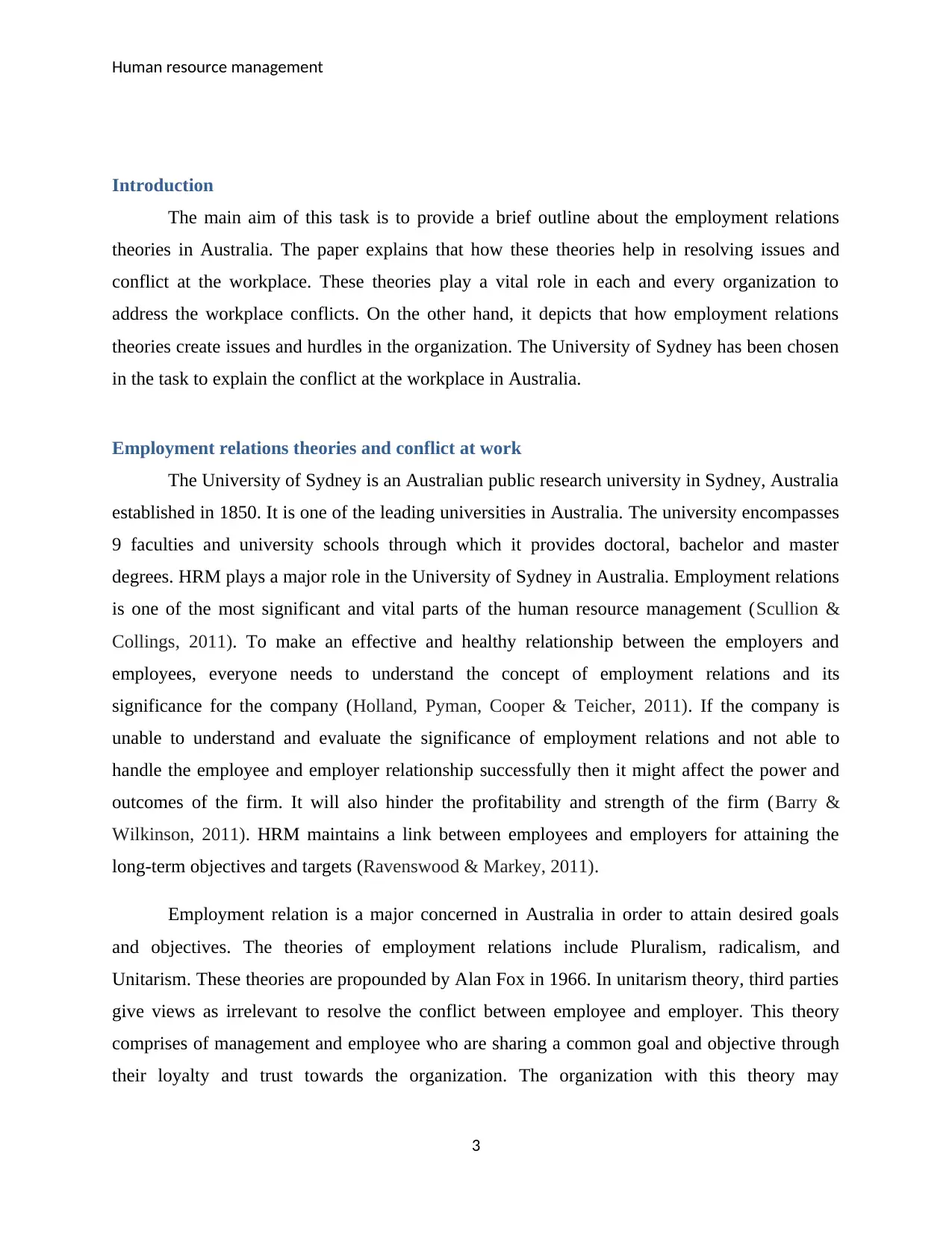
Human resource management
Introduction
The main aim of this task is to provide a brief outline about the employment relations
theories in Australia. The paper explains that how these theories help in resolving issues and
conflict at the workplace. These theories play a vital role in each and every organization to
address the workplace conflicts. On the other hand, it depicts that how employment relations
theories create issues and hurdles in the organization. The University of Sydney has been chosen
in the task to explain the conflict at the workplace in Australia.
Employment relations theories and conflict at work
The University of Sydney is an Australian public research university in Sydney, Australia
established in 1850. It is one of the leading universities in Australia. The university encompasses
9 faculties and university schools through which it provides doctoral, bachelor and master
degrees. HRM plays a major role in the University of Sydney in Australia. Employment relations
is one of the most significant and vital parts of the human resource management (Scullion &
Collings, 2011). To make an effective and healthy relationship between the employers and
employees, everyone needs to understand the concept of employment relations and its
significance for the company (Holland, Pyman, Cooper & Teicher, 2011). If the company is
unable to understand and evaluate the significance of employment relations and not able to
handle the employee and employer relationship successfully then it might affect the power and
outcomes of the firm. It will also hinder the profitability and strength of the firm (Barry &
Wilkinson, 2011). HRM maintains a link between employees and employers for attaining the
long-term objectives and targets (Ravenswood & Markey, 2011).
Employment relation is a major concerned in Australia in order to attain desired goals
and objectives. The theories of employment relations include Pluralism, radicalism, and
Unitarism. These theories are propounded by Alan Fox in 1966. In unitarism theory, third parties
give views as irrelevant to resolve the conflict between employee and employer. This theory
comprises of management and employee who are sharing a common goal and objective through
their loyalty and trust towards the organization. The organization with this theory may
3
Introduction
The main aim of this task is to provide a brief outline about the employment relations
theories in Australia. The paper explains that how these theories help in resolving issues and
conflict at the workplace. These theories play a vital role in each and every organization to
address the workplace conflicts. On the other hand, it depicts that how employment relations
theories create issues and hurdles in the organization. The University of Sydney has been chosen
in the task to explain the conflict at the workplace in Australia.
Employment relations theories and conflict at work
The University of Sydney is an Australian public research university in Sydney, Australia
established in 1850. It is one of the leading universities in Australia. The university encompasses
9 faculties and university schools through which it provides doctoral, bachelor and master
degrees. HRM plays a major role in the University of Sydney in Australia. Employment relations
is one of the most significant and vital parts of the human resource management (Scullion &
Collings, 2011). To make an effective and healthy relationship between the employers and
employees, everyone needs to understand the concept of employment relations and its
significance for the company (Holland, Pyman, Cooper & Teicher, 2011). If the company is
unable to understand and evaluate the significance of employment relations and not able to
handle the employee and employer relationship successfully then it might affect the power and
outcomes of the firm. It will also hinder the profitability and strength of the firm (Barry &
Wilkinson, 2011). HRM maintains a link between employees and employers for attaining the
long-term objectives and targets (Ravenswood & Markey, 2011).
Employment relation is a major concerned in Australia in order to attain desired goals
and objectives. The theories of employment relations include Pluralism, radicalism, and
Unitarism. These theories are propounded by Alan Fox in 1966. In unitarism theory, third parties
give views as irrelevant to resolve the conflict between employee and employer. This theory
comprises of management and employee who are sharing a common goal and objective through
their loyalty and trust towards the organization. The organization with this theory may
3
⊘ This is a preview!⊘
Do you want full access?
Subscribe today to unlock all pages.

Trusted by 1+ million students worldwide

Human resource management
experience misunderstanding and poor communication between the employers and employees.
Ultimately, it affects the success and growth of the company (Cairns & Malloch, 2011).
Let’s talk about the pluralism approach focuses on collective bargaining. It comprises
different interests of the subgroups that can cause conflict and issues between trade union and
management. Pluralism theory is differ from Unitarism in that they start from a set of
assumptions, beliefs, and values in the workplace (Dibben, Wood & Klerck, 2011). This theory
is good and effective for the organization as it leads to the collective bargaining between the
managers and subordinates for unique and effective conflict resolution and handling (Townsend
& Wilkinson, 2011).
Lastly, the radicalism theory suggests that employers and employees are bound to have
conflict and issues due to the result of capitalism. This approach focuses on the idea of control as
most important to the employment relationship and industrial relations. Under this approach, a
trade union is used to protect the rights and interests of the employees with maintaining and
improving the employee's terms and conditions. The potential of employees could be affected
adversely by using this approach (Farr-Wharton, Brunetto & Shacklock, 2011).
Theories of employment relations are not important in Australia because these theories
are unable to provide benefits to the companies. The University of Sydney uses pluralism theory
to maintain an effective and reciprocal relationship with employees in the workplace. Although,
pluralism employment relationship theory encompasses of people with different aspirations,
objectives, and interests who distinguish them from each other as it also affects the success and
growth of the firm adversely. The pluralism theory creates power imbalance between the
competing parties that have varying interest, aspirations and aims. Power imbalance affects the
satisfaction level of employees in Australia. As a result, the employees are unable to maintain a
good relationship with superior at the workplace. Pluralism approach emphasizes more on the
rational, efficient and effective management of issue and conflict within the organization. This
theory focuses on rule, regulations, and process to accommodate and manage conflict instead of
facts as it appears sophisticated in which unions need to be involved. It is noted that pluralism
affects the social stability, concessions, and negotiation. Thus, such emphasizes has the potential
outcome in failure to understand proper results and procedures of the difficult workplace. It
affects the productivity and efficiency of the employees. Apart from this, it shall be stated that
4
experience misunderstanding and poor communication between the employers and employees.
Ultimately, it affects the success and growth of the company (Cairns & Malloch, 2011).
Let’s talk about the pluralism approach focuses on collective bargaining. It comprises
different interests of the subgroups that can cause conflict and issues between trade union and
management. Pluralism theory is differ from Unitarism in that they start from a set of
assumptions, beliefs, and values in the workplace (Dibben, Wood & Klerck, 2011). This theory
is good and effective for the organization as it leads to the collective bargaining between the
managers and subordinates for unique and effective conflict resolution and handling (Townsend
& Wilkinson, 2011).
Lastly, the radicalism theory suggests that employers and employees are bound to have
conflict and issues due to the result of capitalism. This approach focuses on the idea of control as
most important to the employment relationship and industrial relations. Under this approach, a
trade union is used to protect the rights and interests of the employees with maintaining and
improving the employee's terms and conditions. The potential of employees could be affected
adversely by using this approach (Farr-Wharton, Brunetto & Shacklock, 2011).
Theories of employment relations are not important in Australia because these theories
are unable to provide benefits to the companies. The University of Sydney uses pluralism theory
to maintain an effective and reciprocal relationship with employees in the workplace. Although,
pluralism employment relationship theory encompasses of people with different aspirations,
objectives, and interests who distinguish them from each other as it also affects the success and
growth of the firm adversely. The pluralism theory creates power imbalance between the
competing parties that have varying interest, aspirations and aims. Power imbalance affects the
satisfaction level of employees in Australia. As a result, the employees are unable to maintain a
good relationship with superior at the workplace. Pluralism approach emphasizes more on the
rational, efficient and effective management of issue and conflict within the organization. This
theory focuses on rule, regulations, and process to accommodate and manage conflict instead of
facts as it appears sophisticated in which unions need to be involved. It is noted that pluralism
affects the social stability, concessions, and negotiation. Thus, such emphasizes has the potential
outcome in failure to understand proper results and procedures of the difficult workplace. It
affects the productivity and efficiency of the employees. Apart from this, it shall be stated that
4
Paraphrase This Document
Need a fresh take? Get an instant paraphrase of this document with our AI Paraphraser
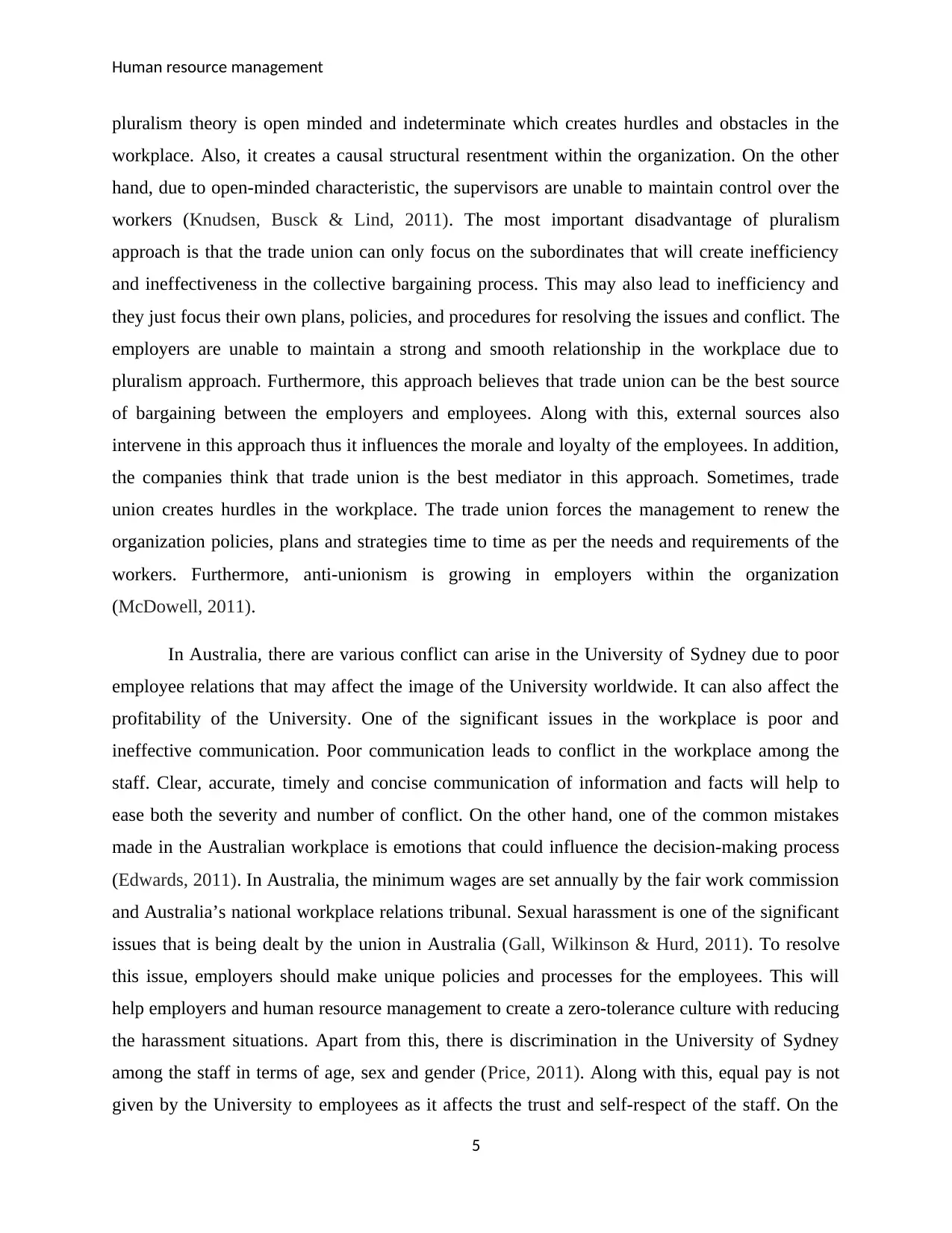
Human resource management
pluralism theory is open minded and indeterminate which creates hurdles and obstacles in the
workplace. Also, it creates a causal structural resentment within the organization. On the other
hand, due to open-minded characteristic, the supervisors are unable to maintain control over the
workers (Knudsen, Busck & Lind, 2011). The most important disadvantage of pluralism
approach is that the trade union can only focus on the subordinates that will create inefficiency
and ineffectiveness in the collective bargaining process. This may also lead to inefficiency and
they just focus their own plans, policies, and procedures for resolving the issues and conflict. The
employers are unable to maintain a strong and smooth relationship in the workplace due to
pluralism approach. Furthermore, this approach believes that trade union can be the best source
of bargaining between the employers and employees. Along with this, external sources also
intervene in this approach thus it influences the morale and loyalty of the employees. In addition,
the companies think that trade union is the best mediator in this approach. Sometimes, trade
union creates hurdles in the workplace. The trade union forces the management to renew the
organization policies, plans and strategies time to time as per the needs and requirements of the
workers. Furthermore, anti-unionism is growing in employers within the organization
(McDowell, 2011).
In Australia, there are various conflict can arise in the University of Sydney due to poor
employee relations that may affect the image of the University worldwide. It can also affect the
profitability of the University. One of the significant issues in the workplace is poor and
ineffective communication. Poor communication leads to conflict in the workplace among the
staff. Clear, accurate, timely and concise communication of information and facts will help to
ease both the severity and number of conflict. On the other hand, one of the common mistakes
made in the Australian workplace is emotions that could influence the decision-making process
(Edwards, 2011). In Australia, the minimum wages are set annually by the fair work commission
and Australia’s national workplace relations tribunal. Sexual harassment is one of the significant
issues that is being dealt by the union in Australia (Gall, Wilkinson & Hurd, 2011). To resolve
this issue, employers should make unique policies and processes for the employees. This will
help employers and human resource management to create a zero-tolerance culture with reducing
the harassment situations. Apart from this, there is discrimination in the University of Sydney
among the staff in terms of age, sex and gender (Price, 2011). Along with this, equal pay is not
given by the University to employees as it affects the trust and self-respect of the staff. On the
5
pluralism theory is open minded and indeterminate which creates hurdles and obstacles in the
workplace. Also, it creates a causal structural resentment within the organization. On the other
hand, due to open-minded characteristic, the supervisors are unable to maintain control over the
workers (Knudsen, Busck & Lind, 2011). The most important disadvantage of pluralism
approach is that the trade union can only focus on the subordinates that will create inefficiency
and ineffectiveness in the collective bargaining process. This may also lead to inefficiency and
they just focus their own plans, policies, and procedures for resolving the issues and conflict. The
employers are unable to maintain a strong and smooth relationship in the workplace due to
pluralism approach. Furthermore, this approach believes that trade union can be the best source
of bargaining between the employers and employees. Along with this, external sources also
intervene in this approach thus it influences the morale and loyalty of the employees. In addition,
the companies think that trade union is the best mediator in this approach. Sometimes, trade
union creates hurdles in the workplace. The trade union forces the management to renew the
organization policies, plans and strategies time to time as per the needs and requirements of the
workers. Furthermore, anti-unionism is growing in employers within the organization
(McDowell, 2011).
In Australia, there are various conflict can arise in the University of Sydney due to poor
employee relations that may affect the image of the University worldwide. It can also affect the
profitability of the University. One of the significant issues in the workplace is poor and
ineffective communication. Poor communication leads to conflict in the workplace among the
staff. Clear, accurate, timely and concise communication of information and facts will help to
ease both the severity and number of conflict. On the other hand, one of the common mistakes
made in the Australian workplace is emotions that could influence the decision-making process
(Edwards, 2011). In Australia, the minimum wages are set annually by the fair work commission
and Australia’s national workplace relations tribunal. Sexual harassment is one of the significant
issues that is being dealt by the union in Australia (Gall, Wilkinson & Hurd, 2011). To resolve
this issue, employers should make unique policies and processes for the employees. This will
help employers and human resource management to create a zero-tolerance culture with reducing
the harassment situations. Apart from this, there is discrimination in the University of Sydney
among the staff in terms of age, sex and gender (Price, 2011). Along with this, equal pay is not
given by the University to employees as it affects the trust and self-respect of the staff. On the
5
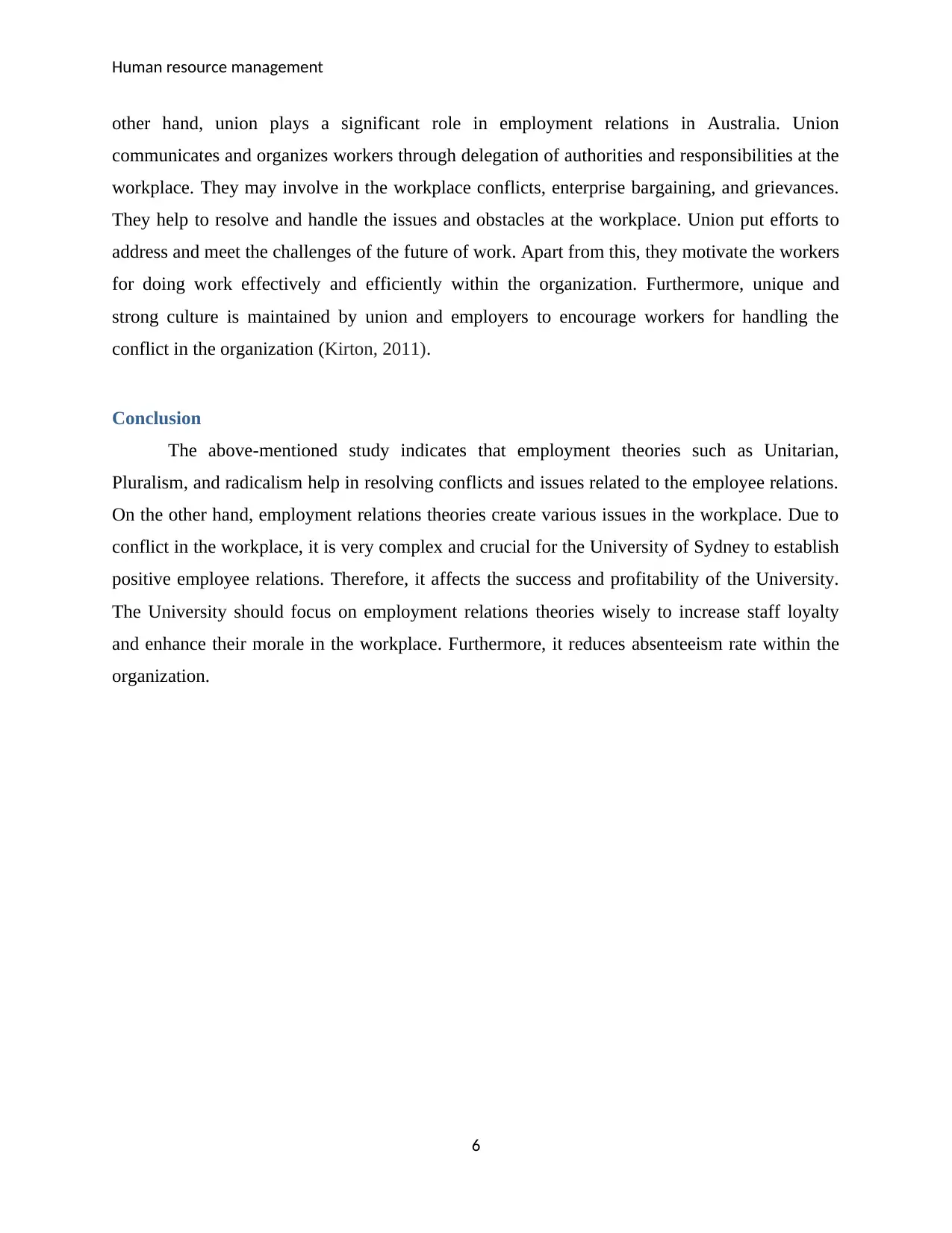
Human resource management
other hand, union plays a significant role in employment relations in Australia. Union
communicates and organizes workers through delegation of authorities and responsibilities at the
workplace. They may involve in the workplace conflicts, enterprise bargaining, and grievances.
They help to resolve and handle the issues and obstacles at the workplace. Union put efforts to
address and meet the challenges of the future of work. Apart from this, they motivate the workers
for doing work effectively and efficiently within the organization. Furthermore, unique and
strong culture is maintained by union and employers to encourage workers for handling the
conflict in the organization (Kirton, 2011).
Conclusion
The above-mentioned study indicates that employment theories such as Unitarian,
Pluralism, and radicalism help in resolving conflicts and issues related to the employee relations.
On the other hand, employment relations theories create various issues in the workplace. Due to
conflict in the workplace, it is very complex and crucial for the University of Sydney to establish
positive employee relations. Therefore, it affects the success and profitability of the University.
The University should focus on employment relations theories wisely to increase staff loyalty
and enhance their morale in the workplace. Furthermore, it reduces absenteeism rate within the
organization.
6
other hand, union plays a significant role in employment relations in Australia. Union
communicates and organizes workers through delegation of authorities and responsibilities at the
workplace. They may involve in the workplace conflicts, enterprise bargaining, and grievances.
They help to resolve and handle the issues and obstacles at the workplace. Union put efforts to
address and meet the challenges of the future of work. Apart from this, they motivate the workers
for doing work effectively and efficiently within the organization. Furthermore, unique and
strong culture is maintained by union and employers to encourage workers for handling the
conflict in the organization (Kirton, 2011).
Conclusion
The above-mentioned study indicates that employment theories such as Unitarian,
Pluralism, and radicalism help in resolving conflicts and issues related to the employee relations.
On the other hand, employment relations theories create various issues in the workplace. Due to
conflict in the workplace, it is very complex and crucial for the University of Sydney to establish
positive employee relations. Therefore, it affects the success and profitability of the University.
The University should focus on employment relations theories wisely to increase staff loyalty
and enhance their morale in the workplace. Furthermore, it reduces absenteeism rate within the
organization.
6
⊘ This is a preview!⊘
Do you want full access?
Subscribe today to unlock all pages.

Trusted by 1+ million students worldwide
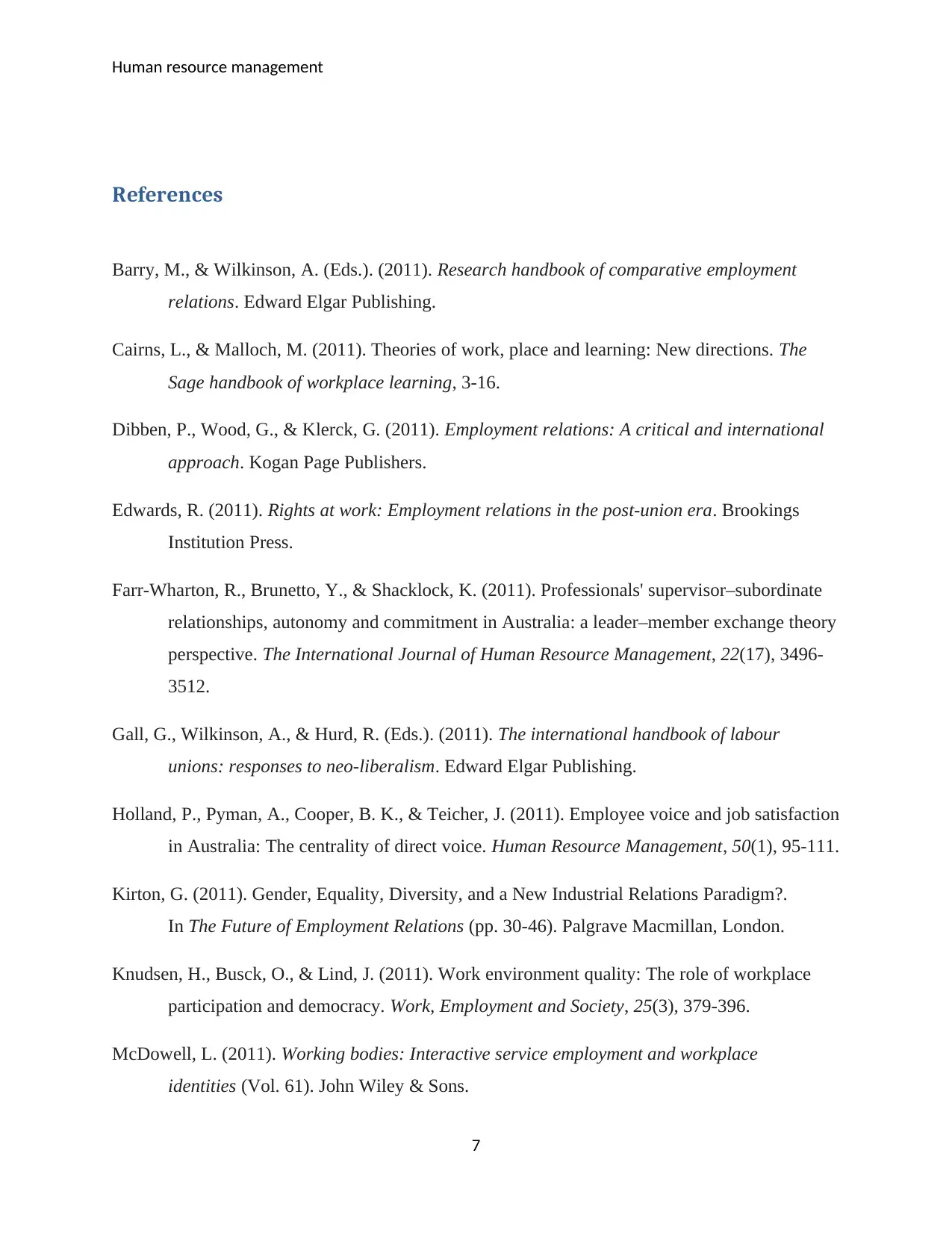
Human resource management
References
Barry, M., & Wilkinson, A. (Eds.). (2011). Research handbook of comparative employment
relations. Edward Elgar Publishing.
Cairns, L., & Malloch, M. (2011). Theories of work, place and learning: New directions. The
Sage handbook of workplace learning, 3-16.
Dibben, P., Wood, G., & Klerck, G. (2011). Employment relations: A critical and international
approach. Kogan Page Publishers.
Edwards, R. (2011). Rights at work: Employment relations in the post-union era. Brookings
Institution Press.
Farr-Wharton, R., Brunetto, Y., & Shacklock, K. (2011). Professionals' supervisor–subordinate
relationships, autonomy and commitment in Australia: a leader–member exchange theory
perspective. The International Journal of Human Resource Management, 22(17), 3496-
3512.
Gall, G., Wilkinson, A., & Hurd, R. (Eds.). (2011). The international handbook of labour
unions: responses to neo-liberalism. Edward Elgar Publishing.
Holland, P., Pyman, A., Cooper, B. K., & Teicher, J. (2011). Employee voice and job satisfaction
in Australia: The centrality of direct voice. Human Resource Management, 50(1), 95-111.
Kirton, G. (2011). Gender, Equality, Diversity, and a New Industrial Relations Paradigm?.
In The Future of Employment Relations (pp. 30-46). Palgrave Macmillan, London.
Knudsen, H., Busck, O., & Lind, J. (2011). Work environment quality: The role of workplace
participation and democracy. Work, Employment and Society, 25(3), 379-396.
McDowell, L. (2011). Working bodies: Interactive service employment and workplace
identities (Vol. 61). John Wiley & Sons.
7
References
Barry, M., & Wilkinson, A. (Eds.). (2011). Research handbook of comparative employment
relations. Edward Elgar Publishing.
Cairns, L., & Malloch, M. (2011). Theories of work, place and learning: New directions. The
Sage handbook of workplace learning, 3-16.
Dibben, P., Wood, G., & Klerck, G. (2011). Employment relations: A critical and international
approach. Kogan Page Publishers.
Edwards, R. (2011). Rights at work: Employment relations in the post-union era. Brookings
Institution Press.
Farr-Wharton, R., Brunetto, Y., & Shacklock, K. (2011). Professionals' supervisor–subordinate
relationships, autonomy and commitment in Australia: a leader–member exchange theory
perspective. The International Journal of Human Resource Management, 22(17), 3496-
3512.
Gall, G., Wilkinson, A., & Hurd, R. (Eds.). (2011). The international handbook of labour
unions: responses to neo-liberalism. Edward Elgar Publishing.
Holland, P., Pyman, A., Cooper, B. K., & Teicher, J. (2011). Employee voice and job satisfaction
in Australia: The centrality of direct voice. Human Resource Management, 50(1), 95-111.
Kirton, G. (2011). Gender, Equality, Diversity, and a New Industrial Relations Paradigm?.
In The Future of Employment Relations (pp. 30-46). Palgrave Macmillan, London.
Knudsen, H., Busck, O., & Lind, J. (2011). Work environment quality: The role of workplace
participation and democracy. Work, Employment and Society, 25(3), 379-396.
McDowell, L. (2011). Working bodies: Interactive service employment and workplace
identities (Vol. 61). John Wiley & Sons.
7
Paraphrase This Document
Need a fresh take? Get an instant paraphrase of this document with our AI Paraphraser
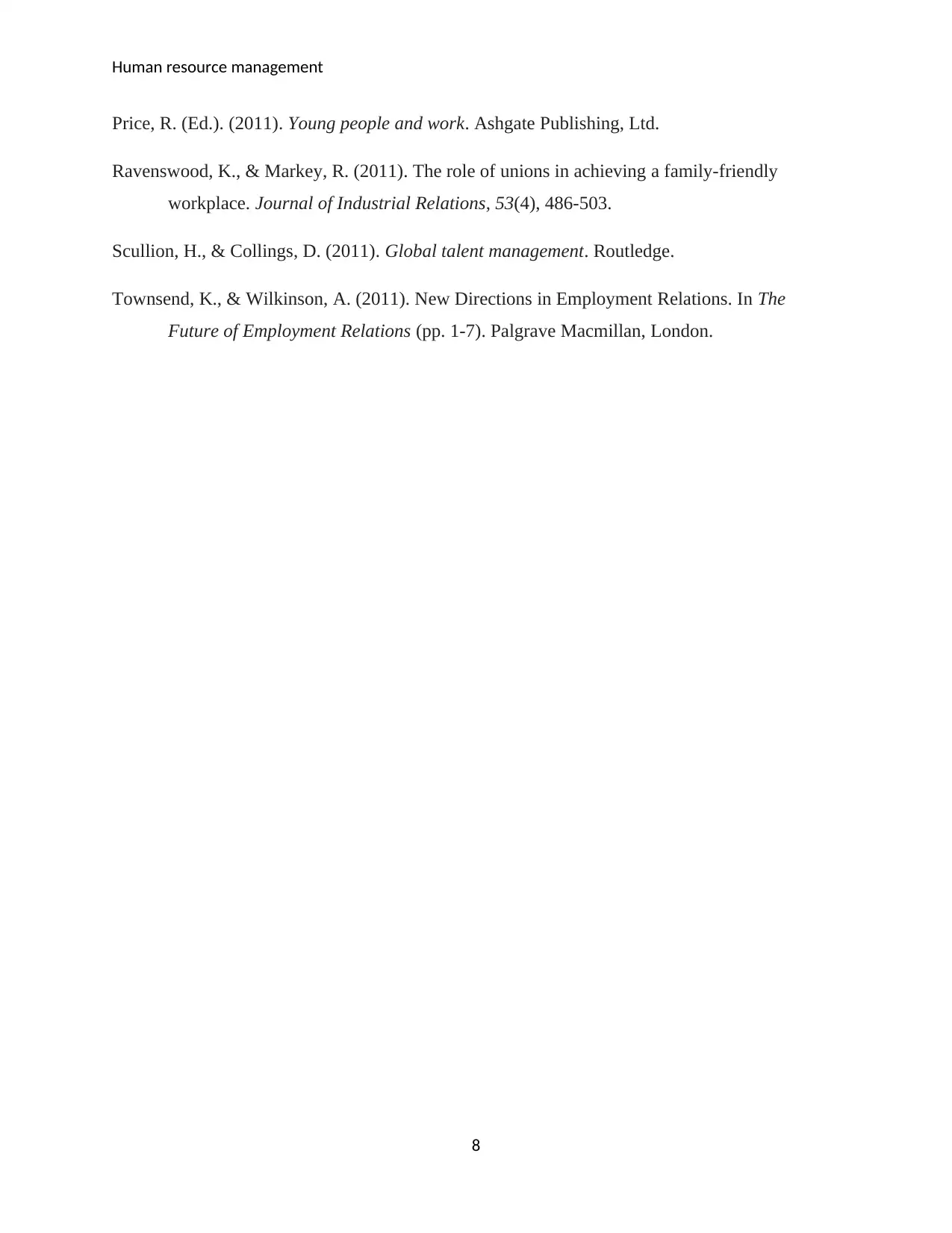
Human resource management
Price, R. (Ed.). (2011). Young people and work. Ashgate Publishing, Ltd.
Ravenswood, K., & Markey, R. (2011). The role of unions in achieving a family-friendly
workplace. Journal of Industrial Relations, 53(4), 486-503.
Scullion, H., & Collings, D. (2011). Global talent management. Routledge.
Townsend, K., & Wilkinson, A. (2011). New Directions in Employment Relations. In The
Future of Employment Relations (pp. 1-7). Palgrave Macmillan, London.
8
Price, R. (Ed.). (2011). Young people and work. Ashgate Publishing, Ltd.
Ravenswood, K., & Markey, R. (2011). The role of unions in achieving a family-friendly
workplace. Journal of Industrial Relations, 53(4), 486-503.
Scullion, H., & Collings, D. (2011). Global talent management. Routledge.
Townsend, K., & Wilkinson, A. (2011). New Directions in Employment Relations. In The
Future of Employment Relations (pp. 1-7). Palgrave Macmillan, London.
8
1 out of 8
Related Documents
Your All-in-One AI-Powered Toolkit for Academic Success.
+13062052269
info@desklib.com
Available 24*7 on WhatsApp / Email
![[object Object]](/_next/static/media/star-bottom.7253800d.svg)
Unlock your academic potential
Copyright © 2020–2025 A2Z Services. All Rights Reserved. Developed and managed by ZUCOL.





